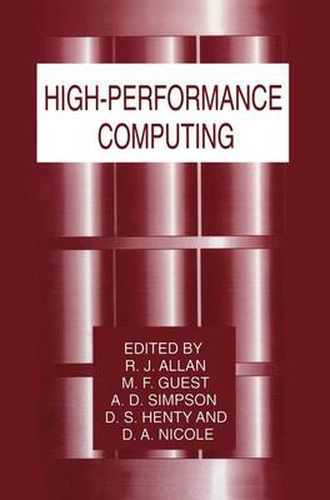Readings Newsletter
Become a Readings Member to make your shopping experience even easier.
Sign in or sign up for free!
You’re not far away from qualifying for FREE standard shipping within Australia
You’ve qualified for FREE standard shipping within Australia
The cart is loading…






This title is printed to order. This book may have been self-published. If so, we cannot guarantee the quality of the content. In the main most books will have gone through the editing process however some may not. We therefore suggest that you be aware of this before ordering this book. If in doubt check either the author or publisher’s details as we are unable to accept any returns unless they are faulty. Please contact us if you have any questions.
Over the past decade high performance computing has demonstrated the ability to model and predict accurately a wide range of physical properties and phenomena. Many of these have had an important impact in contributing to wealth creation and improving the quality of life through the development of new products and processes with greater efficacy, efficiency or reduced harmful side effects, and in contributing to our ability to understand and describe the world around us. Following a survey ofthe U.K.‘s urgent need for a supercomputingfacility for aca demic research (see next chapter), a 256-processor T3D system from Cray Research Inc. went into operation at the University of Edinburgh in the summer of 1994. The High Performance Computing Initiative, HPCI, was established in November 1994 to support and ensure the efficient and effective exploitation of the T3D (and future gen erations of HPC systems) by a number of consortia working in the frontier areas of computational research. The Cray T3D, now comprising 512 processors and total of 32 CB memory, represented a very significant increase in computing power, allowing simulations to move forward on a number offronts. The three-fold aims of the HPCI may be summarised as follows; (1) to seek and maintain a world class position incomputational scienceand engineering, (2) to support and promote exploitation of HPC in industry, commerce and business, and (3) to support education and training in HPC and its application.
$9.00 standard shipping within Australia
FREE standard shipping within Australia for orders over $100.00
Express & International shipping calculated at checkout
This title is printed to order. This book may have been self-published. If so, we cannot guarantee the quality of the content. In the main most books will have gone through the editing process however some may not. We therefore suggest that you be aware of this before ordering this book. If in doubt check either the author or publisher’s details as we are unable to accept any returns unless they are faulty. Please contact us if you have any questions.
Over the past decade high performance computing has demonstrated the ability to model and predict accurately a wide range of physical properties and phenomena. Many of these have had an important impact in contributing to wealth creation and improving the quality of life through the development of new products and processes with greater efficacy, efficiency or reduced harmful side effects, and in contributing to our ability to understand and describe the world around us. Following a survey ofthe U.K.‘s urgent need for a supercomputingfacility for aca demic research (see next chapter), a 256-processor T3D system from Cray Research Inc. went into operation at the University of Edinburgh in the summer of 1994. The High Performance Computing Initiative, HPCI, was established in November 1994 to support and ensure the efficient and effective exploitation of the T3D (and future gen erations of HPC systems) by a number of consortia working in the frontier areas of computational research. The Cray T3D, now comprising 512 processors and total of 32 CB memory, represented a very significant increase in computing power, allowing simulations to move forward on a number offronts. The three-fold aims of the HPCI may be summarised as follows; (1) to seek and maintain a world class position incomputational scienceand engineering, (2) to support and promote exploitation of HPC in industry, commerce and business, and (3) to support education and training in HPC and its application.